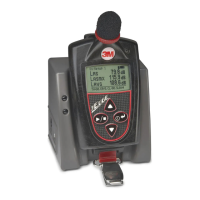Crest Factor
Crest Factor is the ratio of the instantaneous peak value of a wave to its RMS value. This is a performance specification of a
meter’s ability to process signals that have peaks that are substantially higher than their RMS averages.
Criterion Level (CL)
Criterion level is the average SPL that will result in a 100% dose over the Criterion time, usually 8 hours. The Criterion Level
is typically set by a regulating agency, such as OSHA, and is not usually applicable for community noise monitoring.
Examples: OSHA mandates the Criterion Level (maximum allowable accumulated noise exposure) to be 90 dB for 8 hours.
For an 8-hour sample, an average level (LAVG) of 90 dB will result in 100% dose. For the OSHA HEARING
CONSERVATION AMENDMENT, the “action level” is 85 dB for 8 hours. This would result in a 50% dose reading. Note that
the Criterion Level has not changed. (If the Criterion Level were changed to 85 dB then an 8-hour average of 85 dB would
result in 100% dose.)
Criterion Time
The time over which the Criterion Level is established, generally 8 hours.
Decibel (dB)
Sound Level Meters use the decibel as the unit of measure known as Sound Pressure Level (SPL). SPL uses the ratio
between a reference level of 20 microPascals (.00002 Pascals) and the level being measured. SPL = 20 log (measured
level/reference level). Example: the SPL for 1 Pascal is 20 log (1 Pascal/.00002 Pascal) = 94dB 20 microPascals (.00002
Pascals) is considered the average threshold of hearing. A whisper is about 20 dB. A normal conversation is typically from 60
to 70 dB, and a noisy factory from 90 to 100 dB. Loud thunder is approximately 110 dB, and 120 dB borders on the threshold
of pain.
Dose
Related to the Criterion Level, a dose reading of 100% is the maximum allowable exposure to accumulated noise. For OSHA,
100% dose occurs for an average sound level of 90 dB over an 8 hour period (or any equivalent exposure). By using a TWA
reading rather than the average sound level, the time period is no longer explicitly needed. A TWA of 90 dB is the equivalent
of 100% dose. The dose will double (halve) every time the TWA increases (decreases) by the Exchange Rate. Example:
OSHA uses an Exchange Rate of 5 dB. Suppose the TWA is 100 dB. The dose would double for each 5 dB increase over the
Criterion Level of 90 dB. The resulting dose is therefore 400%. If the TWA was instead equal to 80 dB then the dose would
halve for each 5 dB below the Criterion Level. The resulting dose would be 25%. When taking noise samples less that the full
workday, dose is an easy number to work with because it is linear with respect to time. Example: If a 0.5-hour sample results
in 9% dose and the workday is 7.5 hours long, then the dose for the full workday would be a 135% dose (7.5 / 0.5 x 9%). This
is computed making the assumption that the sampled noise will continue at the same levels for the full 7.5-hour workday.

